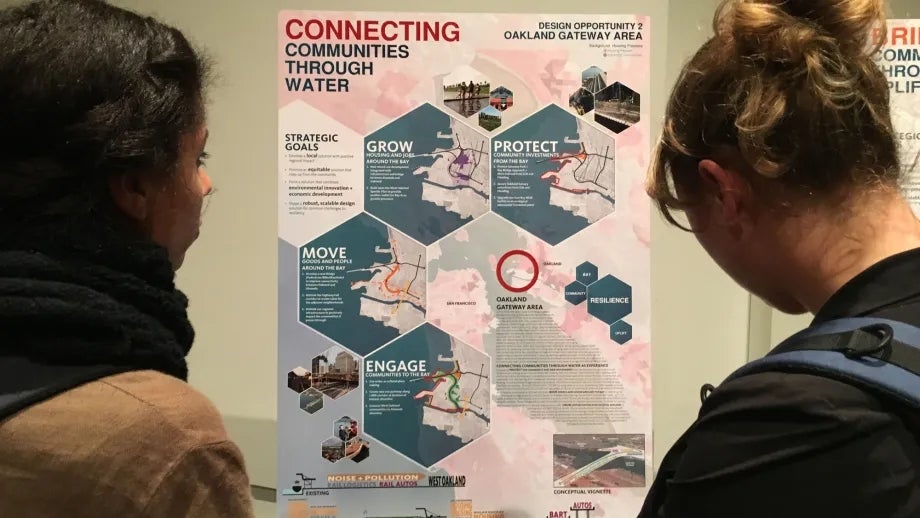Resilient by Design Unveils 32 Innovative Design Opportunities to Address Climate Change
Adapted from a Resilient by Design press release.
Today, Resilient by Design Bay Area Challenge — an exciting new approach to address climate change before disaster strikes — launched online and physical locations for showcasing 32 inspirational Design Opportunities imagined by the 10 Design Teams participating in the Bay Area Challenge. Over the next two weeks, Bay Area residents will be able to view the options in person and virtually, and offer their comments.
The 32 Design Opportunities are available for review and public comment online via Neighborland (through December 1, 2017), and for viewing at locations throughout the Bay Area including SPUR San Francisco, the Bay Area Metro Center (where MTC is housed), SPUR Oakland, SPUR San Jose and the San Mateo County Office in Redwood City (details below). The online gallery features a series of videos explaining each of the concepts.
The public feedback will lay the groundwork for the next phase of the Bay Area Challenge, in which Design Teams will dive deeper to develop 10 of the Design Opportunities in partnership with local leaders and community groups to come up with real, implementable design solutions for building a stronger, safer Bay Area.
“Public engagement is at the center of what Resilient by Design is all about,” said Amanda Brown-Stevens, managing director of Resilient by Design. “It’s about giving all residents, public officials, local leaders and stakeholders a central role in shaping our collective future. During this critical phase of the process, residents will share their thoughts on early inspirations and ideas, so Design Teams can join with local communities to tackle their priorities and concerns together.”
“It’s thrilling to see a variety of approaches and a wide spectrum of ideas emerging,” said Allison Brooks, chair of the Resilient by Design Executive Board. “For me, it’s demonstrative of the imaginative thinking emanating from this Challenge and the broader Bay Area and is proof that the Bay Area Challenge is working to create a new, innovative and replicable approach to addressing sea level rise and climate change.”
Over the past two months, Design Teams have toured communities around the San Francisco Bay, learning about the challenges Bay Area cities face related to severe storms, flooding and sea level rise, in conjunction with broader challenges around infrastructure, affordability and inequity.
In December, after the conclusion of this initial public input, the project's Research Advisory Committee will review the 32 Design Opportunities and consider public feedback. Design Opportunities will be assessed based on innovation, potential benefits to ecological and social resilience, and feasibility. The Research Advisory Committee will select 10 sites that will be matched to 10 Design Teams in the Collaborative Design Phase.
Dates and locations for viewing initial design ideas:
Public Comment Online via Neighborland: www.neighborland.com/resilientbay
November 16-December 1
SPUR San Francisco
November 16-20, 9:00am-5:00pm
654 Mission Street, San Francisco, CA 94105
Bay Area Metro Center (MTC's home base)
November 16-December 1, weekdays 7 am-7 pm; Saturdays 9 am-1 pm
375 Beale Street, San Francisco, CA 94105
SPUR Oakland
November 21, 9 am -4 pm
November 22 & 27, 9 am-5 pm
1544 Broadway, Oakland CA, 94612
SPUR San Jose
November 28 & 30, December 1, 9 am-5 pm
76 South First Street, San Jose, CA 95113
San Mateo County
November 28-December 1, 9 am-5 pm
455 County Center, Redwood City, CA 94063
About Resilient by Design:
Resilient by Design | Bay Area Challenge is a collaborative research and design initiative that connects design leaders to community members, local leaders, and national experts. In a yearlong challenge, 10 Design Teams of landscape architects, engineers, designers, and other experts will work alongside community members and local government to identify critical areas along the San Francisco Bayfront and propose exciting new solutions that will strengthen our region’s resilience to sea level rise, severe storms, flooding and earthquakes.
The Challenge will result in 10 new implementable solutions designed to help communities adapt to the future effects of climate change. These solutions will be designed to improve public access to recreation areas, address housing issues, protect vulnerable infrastructure and strengthen transportation systems.
The Challenge was modeled on New York Rebuild by Design, a partnership of The Rockefeller Foundation and the U.S. Department of Housing and Urban Development (HUD). The Challenge will forge close ties with 100 Resilient Cities, a network pioneered by The Rockefeller Foundation, of which San Francisco, Oakland and Berkeley are members. 100 Resilient Cities is seeking to help 100 cities build resilience to thrive in 21st-century.
The Resilient by Design Executive Board is made up of leaders around the region representing governments, agencies, nonprofits and advocacy groups throughout the Bay Area. The Rockefeller Foundation is providing major funding for this effort, along with other generous funders including The California State Coastal Conservancy, Bay Area Regional Collaborative, The Seed Fund, Santa Clara Valley Water District, City and County of San Francisco, Resources Legacy Fund, Marin Community Foundation, Pacific Gas and Electric, and MTC. Learn more at www.resilientbayarea.org.
Instagram: www.instagram.com/resilientbayarea
Facebook: www.fb.com/resilientbayarea
Twitter: www.twitter.com/resilientbay


Submit your comment
In order to receive a reply to your comment, please provide an email address.